Bowral Veterinary Hospital has vast experience in canine reproduction. Our experienced staff members are skilled in all areas of dog breeding including the latest techniques to ensure you get the results you are after.
The single biggest reason for no pups is a mis-timed mating. Experience and clinical studies have now shown that days in season, discharge colour, vulva size or male interest are very inaccurate methods of assessing when a bitch is ready to mate. By measuring the progesterone levels of your bitch through her heat period, combined with vaginoscopy, we can ensure that mating occurs at the optimal time. This increases the chances of your bitch becoming pregnant.
With the use of our in-house IMMULITE machine, we can obtain the results of blood progesterone tests within two hours. The rapid turnaround can assist in forming the best breeding plans for your bitch. This information, combined with the use of a specialised endoscope that enables us to view the vagina and cervix, enables a very accurate estimation of ovulation to be made.
All diagnostic services are available 365 days a year to ensure that your bitch is inseminated at the best time.
Our collection and vaginal insemination service is a useful and proven technique. The semen is collected, then examined to ensure that the stud dog has provided an adequate sample. The semen is then deposited in the correct area of the cranial vaginal vault. By using the specialised Minitube Mavic catheter with an inflatable balloon, natural mating is most accurately mimicked and backflow of the sample is prevented, ensuring reproduction rates are maximised.
Fresh, frozen or chilled semen may be used in this technique and it can be performed more than once in the same cycle.
At Bowral Veterinary Hospital we have formulated protocols to investigate fertility issues in your animal. This may involve investigating other underlying disease or specific reproductive issues. Various forms of diagnostic imaging, blood tests and biopsy sampling can be used to identify abnormalities.
We offer a collection service, and all our veterinary staff are skilled at using the special equipment required to ensure an adequate sample is collected.
Most days there is an in-season bitch in the hospital that can be used as a teaser when collecting semen from your dog. If fertility is a problem we can perform a full investigative program including a detailed semen assessment and count.
Semen Freezing and Storage Service
At Bowral Veterinary Hospital we use the Camelot pellet semen freezing system, and are certified for use of the system. Our veterinarians are registered by Greyhounds Australia to inseminate greyhounds with frozen semen. By freezing semen, valuable breed lines may be maintained in the event of age, illness or loss of fertility in your stud dog.
Our semen storage facilities are regularly monitored and maintained. They are independently checked on a weekly basis to ensure that your pet's semen is maintained in the optimum conditions. Our liquid nitrogen tanks do NOT rely on electricity and therefore remain unaffected if there is a power failure.
BAER (Brainstem Auditory Evoked Response) hearing testing can be a useful to screen for congenital deafness in puppies. Numerous breeds of dog are prone to genetic deafness and a screening program can help to reduce the incidence of the condition within certain bloodlines. Many dogs are only unilaterally deaf (one sided) and can lead a normal life. These dogs however may be carrying the gene mutation and pass this on to their offspring. The process is painless for the puppies and can be performed relatively quickly in the practice while you wait. Please call the clinic to discuss the screening process further with one of our veterinarians.
AQIS Certification and membership of the Society For Theriogenology (International Body for Veterinary Reproduction)
Bowral Veterinary Hospital has a registered AQIS veterinarian that can assist in advice and documentation for transport of your pets, chilled semen or frozen semen.
Our vets are also members of the Society For Theriogenology (an international body for veterinary reproduction). This will ensure that your pets benefit from the latest ideas and techniques from all corners of the world.
PennHIP radiographs for Hip Dysplasia
PennHIP radiography is a technique for taking radiographs (xrays) of dog's hips to predict the the likelyhood of that dog developing Hip Dysplasia later in life. It can also determine the likelyhood of passing the genetics for Hip Dysplasia on to offspring. It is a much more sensitive and accurate means of measuring than any other technique available. The procedure is controlled through a central agency for consistency of results and our vets are certified to perform the procedure. For more information on this procedure,
please see the PennHIP page on our website.
Pricing and further Information
Please come and visit us, take a tour around the clinic and meet our team.
For more information including pricing please call reception today or email us.
CLIENT BREEDING INFORMATION
What to do when planning to get your bitch pregnant
The main requirement that you need to do is PLAN WELL IN ADVANCE.
Determine which stud dog you are going to use, and work out what is going to be the most appropriate form of insemination for you. Options include natural matings, vaginal artificial insemination, transcervical insemination or surgical insemination.
If you need to travel to the stud dog you are going to use, ensure that you are going to be flexible with timing and ready to travel at short notice. If you are transporting frozen semen, try to transfer the semen to the clinic as soon as possible so it is ready for the bitch when she comes on heat. For chilled semen, it is best to speak directly to one of our veterinarians to help organise timing. Planning may also include organising a second potential stud dog or a second breeding unit of frozen semen ready to use if the first is found to be inadequate.
Once the bitch has come in season, you will need to determine when is the most appropriate time for insemination. As discussed above, insemination timing is the biggest cause of infertility in the bitch. The amount of time that semen can remain viable within the female reproductive tract is extremely variable depending on the type of semen used (fresh, chilled, frozen) and the quality of the semen. Therefore it is of utmost importance to inseminate at the correct time so as viable sperm are present at the exact time that the egg has reached its fertile state. The timing of insemination will vary depending on the type of semen and technique used.
The most accurate and consistent way to chart the oestrus cycle in a bitch is through progesterone testing. Combined with vaginscopy, it can accurately predict when a bitch is ovulating and when the egg is mature and ready to fertilise. Vaginoscopy involves the use of a specialized scope to examine the lining of the vaginal vault. Other clinical signs such as days on heat, vaginal discharge, vulval swelling, male interest, whilst sometimes useful, are not always consistent between bitches.
Please feel free to discuss your requirements with one of our veterinarians and determine what level of testing is most appropriate for you.
What to do throughout the bitch's pregnancy
GESTATION LENGTH - The gestation length in a dog is approximately 63 days from ovulation. If progesterone testing has not been performed throughout the heat cycle, this may translate to a variable gestation length of 55-72 days from the day of mating.
PREGNANCY DIAGNOSIS - Once your bitch has been inseminated, pregnancy may be confirmed via an ultrasound around the 4 week mark. In cases of previous reproductive difficulties, infertility or high value litters, an early ultrasound may be performed at the 3 week mark. If the bitch is pregnant, the progesterone levels may be tested to ensure that the bitch is producing enough progesterone to maintain the pregnancy. Many bitches that have apparently 'never fallen pregnant' are actually suffering from early fetal resorption. This may be treated with progesterone supplementation throughout the pregnancy.
LITTER SIZE - In the final two weeks of pregnancy, an abdominal xray may be performed to count the number of puppies present. This will help when your bitch is whelping so as you can tell how many more puppies are due.
FEEDING - Your bitch should be fed a high quality puppy or pregnancy diet throughout the duration of the pregnancy. Please ensure that you are correctly following the guidelines on the amount of food to be offering your dog. As the pregnancy progresses, your bitch may benefit from multiple smaller portions throughout the day to minimise abdominal discomfort. As long as the bitch is fed a good quality diet, you should NOT supplement the dog with calcium throughout the pregnancy. This practice will actually predispose your bitch to hypocalcaemia/milk fever when she is whelping and lactating. Other vitamins and minerals may cause birth defects when given in high doses. Supplementing may be detrimental to your puppies and a good quality diet will have the correct levels required by the bitch. Calorie requirements increase after about 35 days of pregnancy, so the bitch will require about 1.5-2 times as much feed as usual. During lactation , the bitch may need as much 3 times her usual ration.
WORMING - Most common worming preparations (such as drontal and milbemax) can and should be given to your bitch throughout pregnancy. This may reduce the load of intestinal parasites present in the bitch and minimise the worm burden that is passed to the puppies.
VACCINATION - Ideally, your bitch should have been vaccinated within the previous 6-12 months prior to getting pregnant. If your bitch is unvaccinated, please call the clinic to discuss whether a specialised vaccine that is safe for use in pregnant bitches may be given.
What to do when your bitch is whelping
Prior to the due date, you will need to organise a whelping box for your bitch. The box should be in a quiet warm room where the bitch feels comfortable. It should have enough room for the bitch and puppies and have a high raised edge so as the puppies can not escape from the box. One edge may be cut down to enable the bitch to easily enter and leave the box when she needs to. This box may be home made or may be purchased.
Measuring the body temperature of your bitch is a useful (but not 100% accurate) way of monitoring when your bitch may be due to whelp. It should be measured twice daily, and a drop in temperature may indicate your bitch is due to whelp within the next 12-24 hours. Measuring serum progesterone measurements tends to provide a more accurate assessment of when your dog is due to whelp. An abdominal ultrasound may be performed by your veterinarian at Bowral Veterinary Hospital to determine if the puppies are under stress and require attention.
Stage 1 labour begins with the onset of rhythmic contractions within the uterus. These contractions are usually NOT visible externally. The stage is completed when the cervix has dilated fully. Please note that due to the length of the vagina in a dog, the cervix is NOT able to palpated manually. Stage 1 labour averages 6-12 hours but may last up to 24 hours. During this time your bitch may appear restless, inappetent, may vomit and usually begins nesting or searching for seclusion.
Stage 2 labour begins with the full dilation of the cervix and expulsion of the puppy from the uterus. Stage 3 begins directly after this and involves expulsion of the placenta. In a bitch with more than one puppy, she will alternate between these two stages until all the pups have been born. The length of time of these two stages is highly variable.
Commonly the time of initiation of Stage 2 labour and the birth of the first puppy is 10-30 minutes. Active straining of longer duration than 30 minutes with no sign of a puppy is of concern and you should call the clinic for advice. It is not unusual for a bitch to deliver several puppies, then rest for a period before beginning stage 2 labour again. If there is any panting, muscle tremors or wobbly legs during this period, you should contact the clinic immediately. In this situation a lag of more than four hours is of concern and as mentioned above, any unproductive straining through this period should not last more than 30 minutes without producing a puppy.
The placenta generally passes five to fifteen minutes following the birth of your puppy. The bitch may eat the placenta after it has passed. While this is not a problem, it should not be encouraged as vomiting of placental material is common.
SUMMARY OF CLINICAL SIGNS THAT REQUIRE YOU TO CONTACT THE VET:
- If your bitch does not progress from stage 1 to stage 2 within 6-8 hours
- If your bitch is weak, wobbly or shivering
- If your bitch is in extreme pain
- If you see a dark green vaginal discharge without a puppy being delivered within 30 minutes.
- If your bitch is actively straining for more than 30 minutes without producing a puppy
- If the puppy is visible through the vulva, but is not progressing within 15-20 minutes
What is frozen semen and what are the different types
Frozen semen technology has been around for a few decades and is an area of veterinary science that is constantly evolving and improving over time. Once the fresh semen is collected, it passes through a complex process to preserve the spermatozoa before they are frozen in liquid nitrogen (approximately -200 degrees Celsius). Once they are stored in liquid nitrogen, they can stay there indefinitely.
Frozen semen can either be preserved with the pellet system or the straw system. At Bowral Veterinary Hospital, we use the Camelot pellet system of freezing and achieve excellent thaw rates and excellent fertility rates when they are used on bitches. For the pellet system, once prepared, the seminal fluid is frozen into small pellets (the size of a small ball bearing). A certain number of these pellets are then placed into a vial so that once thawed, there is at least 100 million live sperm ready for insemination. This is referred to as one breeding unit. The number of pellets in each vial will vary depending on the quality of the semen sample. Each vial is clipped on to a cane for storage in the liquid nitrogen tanks. Up to 5 vials may fit on each cane depending on the size of the vials that need to be used.
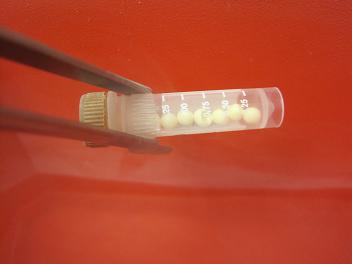
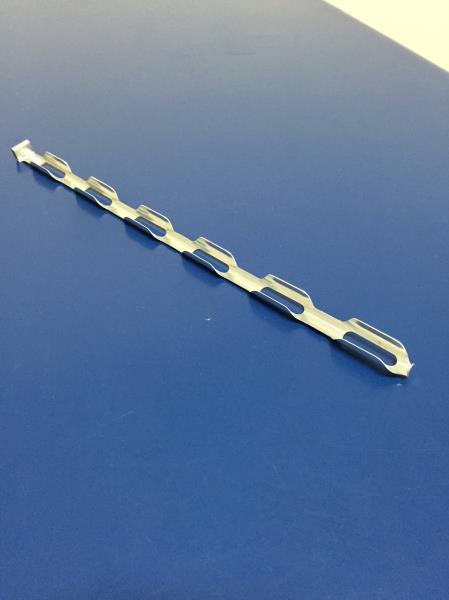
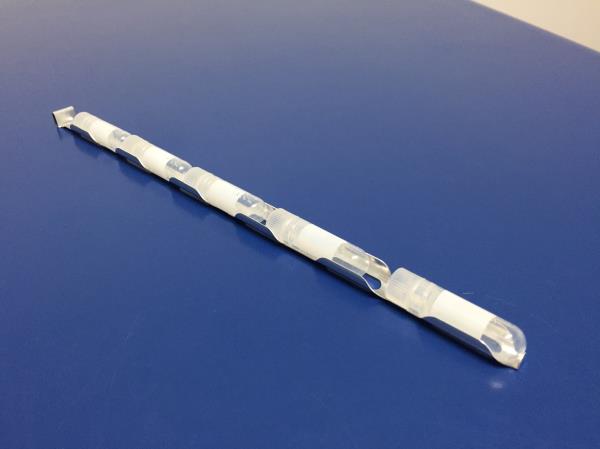
FROZEN PELLETS IN A VIAL A STORAGE CANE FIVE VIALS CLIPPED ON A CANE
With frozen straws, the semen is drawn up in tiny straws that each usually contain 0.5mL. You will need to use a set number of these straws to make it to over 100 million viable sperm (one breeding unit). These numbers are determined at the time of freezing based on the quality of the initial semen sample and how many sperm survive the freeze/thaw process. In semen with a high sperm count, this may be as little as two straws. In other samples, you may need to use 6 or 8 straws. These straws are stored in a goblet. You can fit two goblets on to each cane.
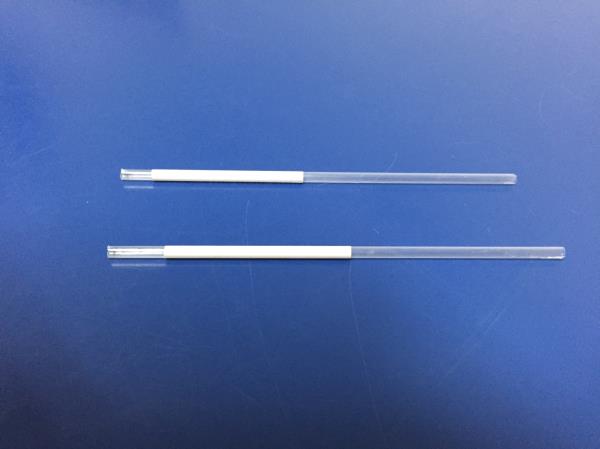
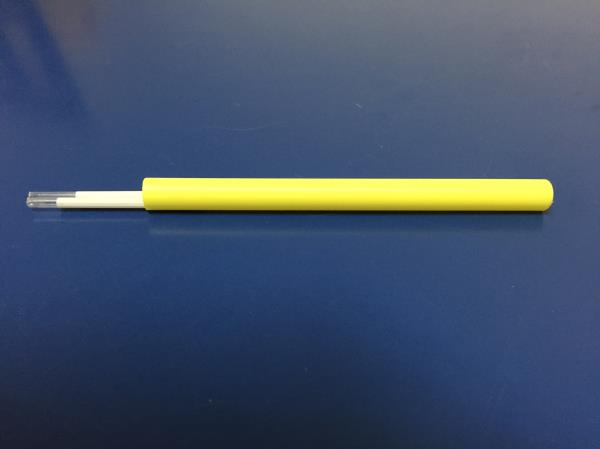
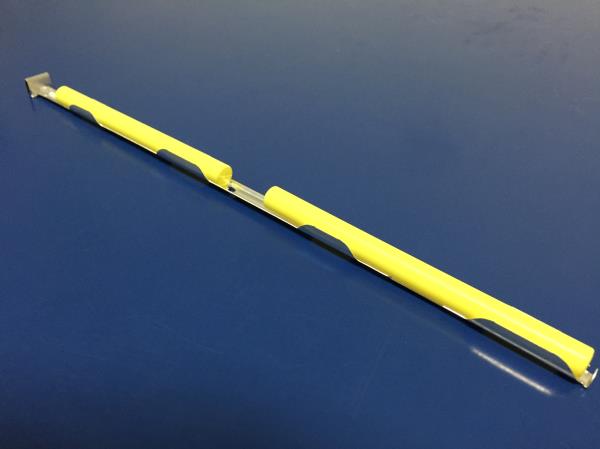
TWO STRAWS A GOBLET TO STORE STRAWS TWO GOBLETS CLIPPED TO A CANE
At Bowral Veterinary Hospital, semen storage fees are based on the number of canes used. The canes are stored in a particular well inside each liquid nitrogen tank.
How to care for your newborn puppies
The most important thing for newborn pups is food, warmth and safety.
Most bitches make excellent mothers and will feed the pups with no problems. In general it is best to handle pups as little as possible in the first 4 weeks of life. The mother will generally provide all the care they need. If a pup is constantly complaining, it is most likely hungry or cold. When a pup is cold, its suckling reflex and digestion is suppressed. Ensure that the pups have a good heat supply but make sure that they are not overheated. If the puppy is hungry and dehydrated, ensure that the bitch is providing enough milk. If the bitch is not, you should contact one of our veterinarians. Occasionally, some puppies may require individual attention to encourage them onto the nipple without other puppies around. Rarely, they may need to be supplemented with formula. Please discuss feeding technique with one of our veterinarians, as aspiration pneumonia is a common problem encountered in puppies receiving supplementary formula.
Weaning occurs at 4-5 weeks after birth. As the pups become more independent, they will start to experiment with food. Moistened good quality dry puppy biscuits are generally sufficient.
Common problems encountered post whelping in the bitch
METRITIS (Inflammation of the uterus) - Signs of this condition are as follows:
fever
foul smelling vaginal discharge
listlessness
loss of appetite
no interest in the pups
decreased milk production
If these signs are noted, usually in the first couple of days post partum, you should contact one of veterinarians immediately. Your dog may have a retained placenta or have suffered some trauma during delivery.
ECLAMPSIA (Hypocalcaemia/milk fever)
This condition results when the bitch has trouble supporting the calcium demand during whelping and lactation. Calcium supplementation throughout the pregnancy will predispose the bitch to this condition. A good quality puppy diet will have the correct ratios of calcium required to minimise chances of this problem. Many smaller breed dogs are at a higher risk of developing this disease.
Early signs of this condition are as follows:
nervousness and restlessness
no interest in the pups
stiff painful gait
These signs progress to:
muscle spasms or tremor
inability to stand
fever
seizures
This condition generally occurs within the first three weeks of lactation and is a medical emergency. If any of these signs are noticed, you should call the clinic immediately.
MASTITIS (Inflammation of the mammary glands)
Normal mammary glands in the bitch are soft enlarged and warm. Diseased glands may be red, hard, painful and hot to touch. The bitch may or may not be systemically sick and generally all other normal glands will still function. Your veterinarian should be contacted for advice if you suspect any signs of mastitis.